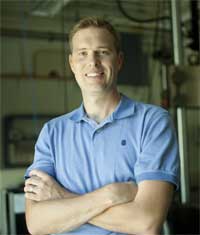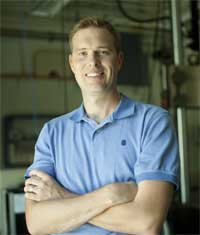 KINGSTON, R.I. – September 19, 2012 — North America’s first offshore wind farm could soon rise off Rhode Island’s coast, and with it will come a real-life laboratory to explore the engineering required to keep the turbines upright as they are pounded by waves, hurricanes and salty air.
KINGSTON, R.I. – September 19, 2012 — North America’s first offshore wind farm could soon rise off Rhode Island’s coast, and with it will come a real-life laboratory to explore the engineering required to keep the turbines upright as they are pounded by waves, hurricanes and salty air.
For Aaron Bradshaw, assistant professor of civil engineering at the University of Rhode Island, the potential to study an offshore wind farm so close to campus comes at the perfect time.
Bradshaw arrived at the University in January 2011 seeking research projects that would mix his passions in geotechnical engineering and the ocean. The planned wind farm in Block Island Sound provides just the fit, plus the chance to write the book on wind turbine foundations in North American waters.
“My interest is in what we can learn from our first experience with these turbines and what can we do to optimize the design,” said Bradshaw, who lives in East Greenwich.
He hopes that wind farm developers will allow him to place measuring instruments on the turbine foundations. The data he collects from the instruments would then be used to assess the performance of the foundation system.
Even if the instruments are never placed on the turbines, there’s plenty of work that can be done. Bradshaw has already begun to explore the behavior of foundations for offshore wind turbines by testing small-scale models in the laboratory.
“What we’re trying to do is reduce the risk and cost in the design of offshore wind structures,” Bradshaw said. “The cost of offshore wind energy must come down to be a competitive alternative energy source.”
Bradshaw is getting some help from his students, who play a key role in all the professor’s research.
“I don’t make a distinction between research and teaching,” he said.
Bradshaw also offers his students a dose of real-world experience. After graduating from Tufts University and URI, he spent three years as a geotechnical engineer in Seattle. As a Ph.D. student at the University, he was tapped by a professor for a research project investigating the liquefaction behavior of soils during earthquakes. In early 2011, he headed to New Zealand for two weeks to study the impact of a 6.3-magnitude earthquake on bridge foundations in the country.
“It doesn’t get any better for me,” Bradshaw said. “This is my dream job.”
Photo by John Peterson

